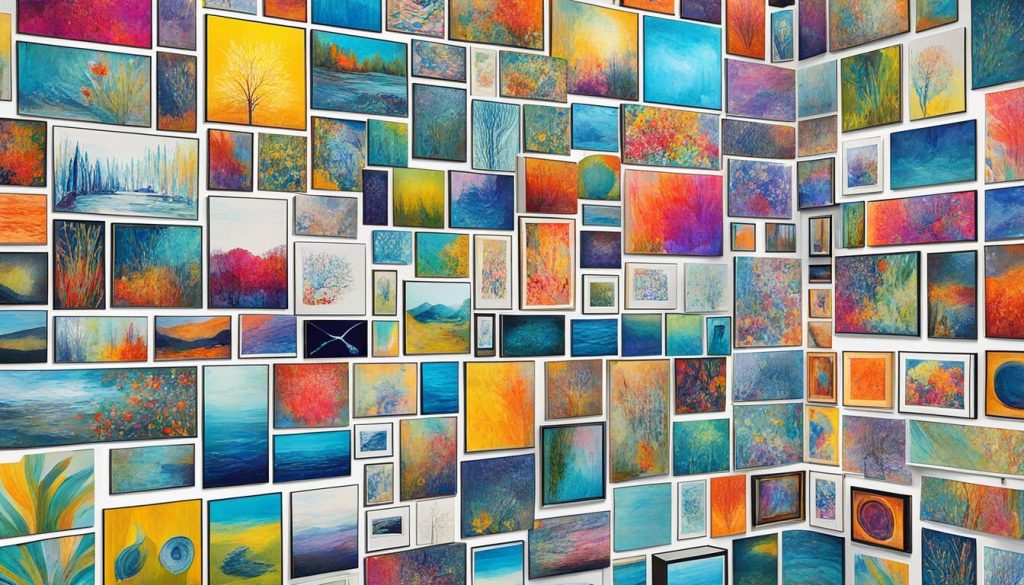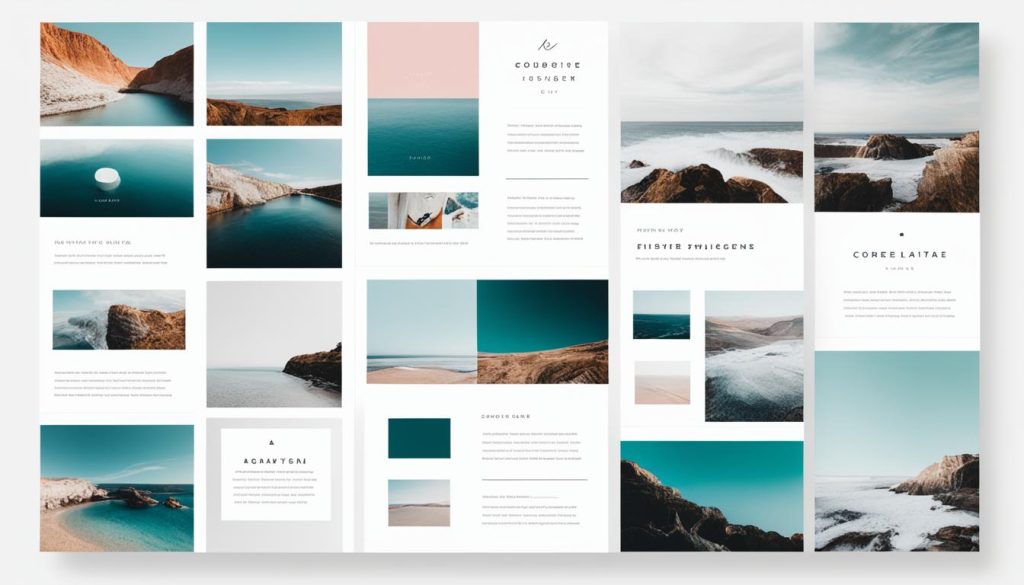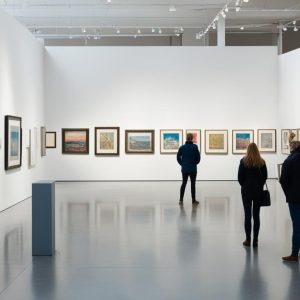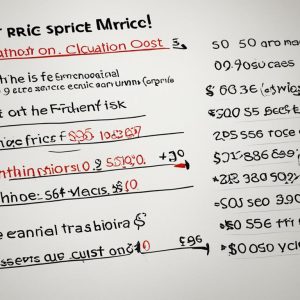As a visual artist, having a website has become essential in today’s digital age. It provides a platform for you to showcase your work, build your brand, and reach a larger audience. With affordable and customizable website options available, you can create a responsive and user-friendly online presence that reflects your unique style and artistic vision.
A professional portfolio website is crucial for artists, as it not only allows you to display your artwork but also ensures that your website is SEO-friendly. This means that your website can be easily discovered by search engines, increasing your visibility and attracting potential buyers.
Whether you choose from a wide range of artist website templates or opt for artist website development services to create a personalized website, having an online presence is essential for establishing yourself as a reputable artist in the digital realm.
With a website, you can showcase your art, share your inspiration and creative process, and engage with your audience. It also offers the convenience of direct sales, allowing you to sell your work directly to interested buyers without the need for intermediaries, galleries, or exhibitions.
So, don’t miss out on the opportunities that having a website can bring. Create your online portfolio today and position yourself for success as a modern visual artist.
Key Takeaways:
- Having a website is essential for modern visual artists to showcase their work, build their brand, and reach a wider audience.
- Affordable and customizable options are available for creating artist websites that are responsive, user-friendly, and SEO-friendly.
- Professional portfolio websites help artists gain visibility and attract potential buyers.
- A website allows artists to engage with their audience, share their inspiration and creative process, and facilitate direct sales.
- Creating a website provides a platform for establishing yourself as a reputable and successful artist in the digital realm.
The Benefits of Having a Website for Artists
Having a website offers numerous benefits for artists. It provides them with an online presence, allowing them to showcase their art to a larger audience. With a website, artists can reach a broad audience that extends beyond their local community, enabling them to connect with art enthusiasts from all over the world.
One of the major advantages of a website is its cost-effectiveness. Instead of relying solely on physical galleries or exhibitions, which can be expensive and limited in terms of reach, artists can use their website as a virtual gallery where they can display their entire portfolio. This saves them money while providing a platform to showcase their work to a wider audience.
A website also offers unlimited inspiration for artists. Through online platforms, they can explore the work of fellow artists, gain exposure to different artistic styles, and expand their creative horizons.
In addition to inspiration, a website can foster community building among artists. Artists can connect with each other, share ideas, provide feedback, and support one another through online forums and communities.
Furthermore, a website enables artists to engage with their audience and cultivate a loyal fan base. Visitors can leave comments, ask questions, and express their admiration for the artwork, leading to meaningful interactions and a sense of connection.
Another significant advantage of having a website is the opportunity for direct sales. Artists can sell their artwork directly to interested buyers through their website, eliminating the need for intermediaries and enabling them to have full control over their sales process.
“Having a website allows me to showcase my art to a global audience and establish my online presence as an artist. It has opened up new opportunities for generating income and connecting with collectors and art enthusiasts from around the world.” – Emily Thompson, Artist
In conclusion, a website provides artists with an array of benefits. It grants them an online presence, facilitates a broad reach, is cost-effective compared to physical galleries, offers unlimited inspiration, allows for community building within the artistic community, promotes audience engagement, and enables direct sales. Artists who leverage the power of websites can establish a strong online presence, expand their reach, and connect with a global audience.
Choosing the Right Social Media Platforms for Art Marketing
Social media has become a powerful marketing channel for artists. With a variety of platforms to choose from, artists can showcase their art, engage with the community, and build their brand. Each platform offers unique features and benefits, allowing artists to tailor their social media presence to their specific needs and goals. Let’s explore some of the best social media platforms for artists:
Instagram is a preferred platform for artists to showcase their artwork to a wide audience. With its visually-focused nature, artists can share their creations through images and videos, engaging with art enthusiasts and potential buyers.
Facebook allows artists to create a professional artist page, connect with specific art communities, and engage with a diverse audience. Artists can share their work, receive feedback, and promote their upcoming projects and exhibitions.
DeviantArt
DeviantArt is an online community specifically tailored for artists. It offers a platform to share artwork, connect with fellow artists, and become part of a supportive artistic community. Artists can receive feedback, participate in contests, and showcase their portfolio.
Behance
Behance is a popular platform for creating a professional portfolio. Artists can showcase their work, connect with other creative professionals, and gain exposure within the design and art industry. Behance is a great choice for artists looking to attract potential clients and collaborators.
Pinterest is a platform that can drive traffic to an artist’s website or online store. Artists can create visually appealing boards to showcase their artwork and attract potential buyers. By leveraging Pinterest’s search functionality and utilizing relevant keywords, artists can reach a broader audience.
YouTube
YouTube allows artists to share their artistic process, tutorials, and behind-the-scenes footage. Artists can engage with their audience through videos, build a loyal subscriber base, and showcase their talent to a global community.
TikTok
TikTok is a rapidly growing platform that offers artists the opportunity to showcase their work through short-form videos. Artists can create engaging and visually appealing content, reach a younger audience, and tap into the platform’s viral nature.
Tumblr
Tumblr provides a space for artists to engage with a diverse community. Artists can share their artwork, connect with like-minded individuals, and explore various art forms. Tumblr allows artists to express their creativity and build a loyal following.
ArtStation
ArtStation focuses on concept art and digital illustration, making it an ideal platform for professionals in the entertainment industry. Artists can showcase their work, connect with industry experts, and gain exposure within the digital art community.
When choosing the right social media platforms for art marketing, it’s essential to consider your goals, target audience, and the type of content you want to share. By strategically utilizing these platforms, artists can effectively promote their art, engage with their audience, and build a strong online presence.
Inspiring Examples of Artist Websites
When it comes to showcasing art online, artist websites play a crucial role in providing a platform for artists to display their work and connect with art enthusiasts. Here are some inspiring examples of artist websites across different art forms:
-
Artist Portfolio Websites:
Artists like Jane Thompson and Michael Rodriguez have created stunning portfolio websites that showcase their diverse range of artwork. These websites feature a collection of their best pieces, organized by style, medium, or theme. Visitors can easily navigate through their portfolios and get a comprehensive view of their artistic journey.
-
Artist Ecommerce Websites:
For artists looking to sell their work online, artist ecommerce websites like Grace Anderson Art and David Parker Prints provide a seamless buying experience. These websites feature an online store where visitors can browse through available artwork, view detailed images, and make purchases securely. The integration of a shopping cart and secure payment options ensures a smooth transaction process.
-
Fine Art Photography Websites:
Photographers like Laura Evans and Matthew Turner have captivating fine art photography websites that showcase their exceptional talent in capturing visually stunning moments. These websites often feature galleries of their best photographs, each with its own story. The use of high-resolution images and well-designed layouts brings their art to life.
-
Painter Websites:
Painter websites like Sarah Marshall Art and James Campbell Paintings display the beauty and mastery of their artistry. From abstract works to realistic portraiture, these websites showcase paintings that evoke emotions and spark creativity. Visitors can explore the various styles and techniques used by the painters, immersing themselves in the world of color, texture, and expression.
-
Photographer Websites:
Photographer websites like Emily Morgan Photos and Alex Carter Photography showcase the power of visual storytelling through captivating images. These websites often feature galleries or portfolios that highlight moments frozen in time. From capturing stunning landscapes to intimate portraits, these photographers use their websites to share their unique perspectives and artistic visions.
-
Sculptor Websites:
Sculptors like Olivia Cooper and Ethan Thompson sculptor have websites that showcase their mastery in three-dimensional art forms. These websites often feature galleries or portfolios of their sculptures, allowing visitors to appreciate the intricate details, textures, and craftsmanship. The use of high-quality images and 360-degree views provides an immersive experience.
If you’re an artist looking to create your own online presence, draw inspiration from these artists and their websites. Remember, your website is a reflection of your art and creativity, so make sure to design a platform that truly showcases your talent.

Elements of an Effective Artist Website
An effective artist website is crucial for showcasing your work and connecting with potential buyers and art enthusiasts. To ensure your website stands out and leaves a lasting impression, here are some key elements to consider:
- Visually Appealing Design: Your website design should reflect your artistic style and create a visually engaging experience for visitors. Choose a layout, color scheme, and typography that align with your brand and complement your artwork.
- User-Friendly Navigation: Make it easy for visitors to navigate through your website and find the information they’re looking for. A clear and intuitive menu structure, with well-organized categories and pages, will enhance the user experience.
- High-Quality Images: Showcase your artwork in the best possible way by using high-resolution, professionally captured images. Optimize these images for web display to ensure fast loading times and an immersive visual experience.
- Clear Contact Information: Make it effortless for potential buyers or art enthusiasts to get in touch with you. Provide clear and prominent contact information, such as your email address or a contact form, so visitors can easily reach out with inquiries or purchase requests.
- Artist Biography: Include a well-written artist biography that provides insight into your background, artistic journey, and influences. This personal touch helps establish a connection with your audience and adds depth to your artistic identity.
- Artist Statement: Craft a compelling artist statement that communicates your artistic vision, concepts, and motivations. This statement provides context for your artwork and allows visitors to understand the deeper meanings behind your creations.
- Online Store: If you sell your artwork online, integrate a secure and user-friendly online store into your website. This allows customers to browse and purchase your art directly from your website, providing a seamless and convenient buying experience.
By incorporating these elements into your artist website, you can create a captivating online presence that effectively showcases your artwork, engages your audience, and supports your artistic career.

Tips for Optimizing an Artist Website for Search Engines
Optimizing an artist website for search engines is crucial to increase visibility and drive organic traffic. As an artist, you want your website to be easily discoverable by potential buyers and art enthusiasts. Here are some valuable tips for improving the search engine optimization (SEO) of your artist website:
- Keyword Research: Conduct thorough keyword research to identify relevant keywords that resonate with your art and target audience. Incorporate these keywords strategically within your website content to enhance its SEO.
- Meta Tags Optimization: Optimize your website’s meta tags, including meta titles and meta descriptions. Craft compelling and descriptive meta tags that accurately represent the content of each page. This can significantly improve your search engine rankings.
- Image Optimization: When adding images to your artist website, be sure to optimize them. Use descriptive file names for your images and include alt tags that provide alternative text descriptions. This not only improves accessibility but also allows search engines to better understand the content of your images.
- Backlinking: Build a network of backlinks by having reputable websites link to your artist website. Backlinks from relevant and authoritative sources can boost your website’s credibility and improve its search engine rankings.
- Content Creation: Regularly create new and engaging content, such as blog posts, that showcases your artwork, shares your artistic process, and provides informative and valuable insights. This not only attracts visitors but also helps improve your website’s overall SEO.
- Social Media Integration: Integrate your social media platforms into your artist website. This allows visitors to easily navigate and engage with your social media profiles, increasing visibility and enhancing audience engagement.
By implementing these SEO strategies, you can optimize your artist website to its fullest potential, increase visibility, and attract a larger audience of art enthusiasts and potential buyers.
Showcasing Art on Social Media – Best Practices
When it comes to showcasing art on social media, there are several best practices that artists can follow to maximize their impact and engagement. By implementing these strategies, artists can effectively promote their work, attract a wider audience, and build a strong online presence.
Create Engaging Content with Visual Storytelling
Engaging content is key to capturing the attention of your audience on social media. Use visually captivating images and videos that tell a story and evoke emotions. Showcasing your creative process, sharing behind-the-scenes glimpses, or narrating the inspiration behind your artwork can make your content more compelling and resonate with your followers.
Hashtags are powerful tools for increasing the discoverability of your art on social media. Research relevant and popular hashtags related to your artwork and incorporate them into your posts. This will help your content reach a wider audience, attract art enthusiasts, and increase your visibility within the artistic community.
Engage with Your Community
Building a loyal fan base requires active engagement with your audience on social media. Respond to comments, messages, and inquiries in a timely manner, and foster conversations around your art. Show genuine interest in your followers by asking for their opinions and encouraging them to share their thoughts. This will create a sense of community and strengthen your relationship with your fans.
Establish Consistent Branding
Consistent branding across your social media platforms is essential for establishing a strong online identity. Use consistent profile pictures, cover photos, and color schemes that align with your art and personal brand. This will help your audience recognize and remember your work, and build brand recognition over time.
Monitor Analytics for Data-Driven Insights
Analyzing social media analytics and metrics can provide valuable insights into the effectiveness of your art marketing strategies. Track metrics such as engagement rates, reach, and follower growth to understand what content resonates most with your audience. Use this data to refine your social media marketing approach and optimize your content for maximum impact.
By following these best practices, artists can effectively showcase their art on social media, attract a wider audience, and build a strong online presence. Engaging content, visual storytelling, strategic use of hashtags, community engagement, consistent branding, and data-driven insights from analytics can all contribute to a successful social media art marketing strategy.
Conclusion
Having a website is essential for modern visual artists to establish their online presence, reach a broader audience, and facilitate direct sales. With the power of websites and social media platforms, artists can build their brand and connect with art enthusiasts and potential buyers.
By creating a professional artist website, artists can showcase their work, share their artistic journey, and provide a platform for direct sales. Websites offer numerous benefits, including cost-effectiveness, unlimited inspiration from the global artistic community, and the ability to engage with the audience.
In addition to websites, social media plays a crucial role in art marketing. Artists can leverage social media platforms to showcase their art, connect with the artistic community, and build their brand. With strategic use of engaging content, hashtags, and consistent branding, artists can attract a broader audience and create a loyal fan base.
By combining the strength of artist websites and social media, artists can establish a strong online presence, gain visibility, and expand their reach. With their unique talents and creative expression, artists can thrive in the digital age while connecting with art enthusiasts worldwide.
FAQ
Why is having a website important for modern visual artists?
What are the benefits of having a website for artists?
Can you provide some inspiring examples of artist websites?
What elements should an effective artist website have?
How can I optimize my artist website for search engines?
Share this content:






